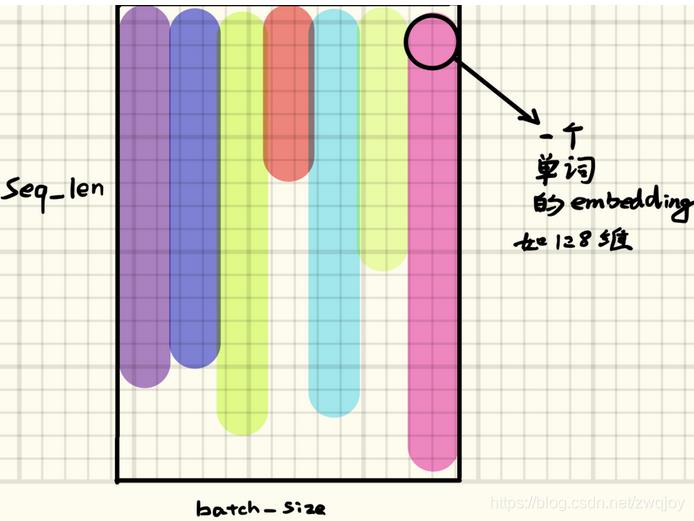PyTorch:Encoder-RNN|LSTM|GRU
Posted -柚子皮-
tags:
篇首语:本文由小常识网(cha138.com)小编为大家整理,主要介绍了PyTorch:Encoder-RNN|LSTM|GRU相关的知识,希望对你有一定的参考价值。
RNN
参数
Parameters
input_size – The number of expected features in the input x
hidden_size – The number of features in the hidden state h
num_layers – Number of recurrent layers. E.g., setting num_layers=2 would mean stacking two RNNs together to form a stacked RNN, with the second RNN taking in outputs of the first RNN and computing the final results. Default: 1 堆叠层数
nonlinearity – The non-linearity to use. Can be either 'tanh' or 'relu'. Default: 'tanh'
bias – If False, then the layer does not use bias weights b_ih and b_hh. Default: True
batch_first – If True, then the input and output tensors are provided as (batch, seq, feature). Default: False
dropout – If non-zero, introduces a Dropout layer on the outputs of each RNN layer except the last layer, with dropout probability equal to dropout. Default: 0
bidirectional – If True, becomes a bidirectional RNN. Default: False 是否使用双向rnn。
Note: RNN这里的序列长度,是动态的,不写在参数里的,具体会由输入的input参数而定。
Inputs: input, h_0
input维度 input of shape (seq_len, batch, input_size): tensor containing the features of the input sequence. The input can also be a packed variable length sequence. See torch.nn.utils.rnn.pack_padded_sequence() or torch.nn.utils.rnn.pack_sequence() for details.

[https://blog.csdn.net/zwqjoy/article/details/86490098]
h0维度 h_0 of shape (num_layers * num_directions, batch, hidden_size): tensor containing the initial hidden state for each element in the batch. Defaults to zero if not provided. If the RNN is bidirectional, num_directions should be 2, else it should be 1.h0是提供给每层RNN的初始输入,所有num_layers要和RNN的num_layers对得上。
Outputs: output, h_n
output of shape (seq_len, batch, num_directions * hidden_size): tensor containing the output features (h_t) from the last layer of the RNN, for each t. If a torch.nn.utils.rnn.PackedSequence has been given as the input, the output will also be a packed sequence.For the unpacked case, the directions can be separated using output.view(seq_len, batch, num_directions, hidden_size), with forward and backward being direction 0 and 1 respectively. Similarly, the directions can be separated in the packed case.RNN的上侧输出。
h_n of shape (num_layers * num_directions, batch, hidden_size): tensor containing the hidden state for t = seq_len.Like output, the layers can be separated using h_n.view(num_layers, num_directions, batch, hidden_size).RNN的右侧输出,如果是双向的话,就还有一个左侧输出。
具体参数和返回结果参考[https://pytorch.org/docs/stable/generated/torch.nn.RNN.html#torch.nn.RNN]
示例
rnn=nn.RNN(10,20,2) #(each_input_size, hidden_state, num_layers)
input=torch.randn(5,3,10) # (seq_len, batch, input_size)
h0=torch.randn(2,3,20) #(num_layers * num_directions, batch, hidden_size)
output,hn=rnn(input,h0)
print(output.size(),hn.size())
LSTM
具体参数和返回结果参考[https://pytorch.org/docs/stable/generated/torch.nn.LSTM.html#torch.nn.LSTM]
示例
rnn=nn.LSTM(10,20,2) #(each_input_size, hidden_state, num_layers)
input=torch.randn(5,3,10) # (seq_len, batch, input_size)
h0=torch.randn(2,3,20) #(num_layers * num_directions, batch, hidden_size)
c0=torch.randn(2,3,20) #(num_layers * num_directions, batch, hidden_size)
output,(hn,cn)=rnn(input,(h0,c0)) #seq_len x batch x hidden*bi_directional
print(output.size(),hn.size(),cn.size())
GRU
gru = nn.GRU(embed_size, hidden_size, n_layers, dropout=dropout, bidirectional=True)
具体参数参考:[https://pytorch.org/docs/stable/generated/torch.nn.GRU.html#gru]
示例
import torch
import torch.nn as nn
rnn = nn.GRU(2, 4, 2,bidirectional=True)
input = torch.randn(2, 2, 2)
h0 = torch.randn(4, 2, 4)
output, hn = rnn(input, h0)
print(output)
print(hn)
print(output.size(),hn.size())
from: -柚子皮-
ref:[LSTM和GRU原理及pytorch代码,输入输出大小说明]
以上是关于PyTorch:Encoder-RNN|LSTM|GRU的主要内容,如果未能解决你的问题,请参考以下文章